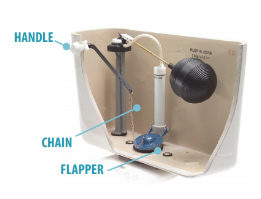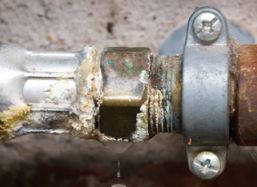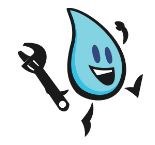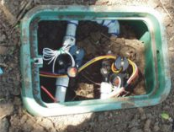Undetected leaks can be the biggest culprit when it comes to water waste inside and outside your home. They’re common and can easily go unnoticed, and could be adding dollars to your water bill.
Note: If you are unable to view/play the videos on this web page, simply click on the associated link(s) to view them full-size in a separate window.
Fixing a Toilet Leak: https://www.youtube.com/watch?time_continue=6&v=NH7HvlYEoYs
Sprinkler System Leak Repair: https://www.youtube.com/watch?v=Sqh8Z5BAK88
Check Your Sprinklers for Overspray: https://www.youtube.com/watch?v=njDNm-lXl_Y
 Find a Leak…Fix a Leak
Find a Leak…Fix a Leak
Act Quickly to Save $ and Water!
Residential water leaks:
- Increase your water bill (sometimes by several hundred dollars per month) until fixed — includes regular rates plus penalties
- Waste many thousands of gallons of our precious water (typically from 10,000 to 60,000 per leak per month!)
Find a Leak:
Look at your meter:
Most meters have some indicator that will spin or revolve whenever water is running. If no water is known to be on, this will tell you if water is flowing through your meter.
About 95% of residential meters are located near the front sidewalk or property line bordering the street. Some are in alleys. It often says “Water Meter” on the plate covering the meter. You can usually pry the lid open with a screwdriver. Use a wet rag/paper towel to clean the meter face.
Review your water bills:
- Tracking your water use over several months can help you recognize that a leak is occurring and how large it might be.
- Water use should be low in the winter months (Nov-Mar) — homes typically use from 2 to 8 units in those months, depending on the number of people in the home (1,500 to 6,000 gallons/month).
Look and Listen to every water-using feature of your home:
-
- The shutoff valves usually look like an outside faucet valve handle and are round:
Near the hot water tank – usually on the wall behind the tank.
Under the kitchen sink or any of the bathroom sinks. It is a third valve – in addition to the one for hot water and the one for cold water.
Warning: Since these valves are not turned often – they may not turn well or fully or at all. If they are hard to turn off by hand – call a plumber. It is an immediate big leak if the valve breaks.
Fix It: If house has a main shutoff valve, turn it off and see if the meter is still running.
Water Softener
– Valves stay open all of the time – you can hear it running in the daytime.
Fix It: Close the “Bypass” valve.
Appliances, incoming water hoses, or faucet handles
Fix It: Observe, replace washers in valve stems, and replace bad valves or hoses.
For leaks that you can’t find yourself, call the Water Authority conservation hotline:
842-WATR (9287) – Option #4
- Open irrigation covers, put your ear on faucets, lift toilet tank lids, and walk through your yard looking for anything unusually wet.
Fix a Leak:
The most common sources of leaks in the home in order of likelihood are:
Toilets
- Bad flapper or bad fill valve

- Water motion in toilet
- Hear water running Water level higher than the over flow tube
- Perform a dye test to check if water is continuously running from tank to bowl. Perform by using food color drops or any colorful drink.
- Observe the water level in tank. It should be about ½’ to 1” below the top of the overflow tube.
- Listen carefully to the fill valve – it should quickly shut off completely when the tank is filled – but if it still drips or makes a fizzing sound the fill valve is bad and should be replaced.
- Broken handle
- Loose chain
Fix It: If meter shows water flowing, then turn off toilet valves, one at a time. Re-observe meter to see if movement stops. Tighten or replace suspect parts.
Irrigation System
- There are many leaks possible in the irrigation system:
-
- If the meter is moving constantly, then the valve box could be the source of the leak – but only, of course, if the leak in the valve box is located between the meter and the valve.
- Water in the valve box could also be present due to a leak beyond or at the yard side of the valve – although the meter would not be constantly moving. It would only occur when the irrigation system is running.
- If the meter is moving constantly, then the valve box could be the source of the leak – but only, of course, if the leak in the valve box is located between the meter and the valve.
-
- If the meter is moving constantly, then the valve box could be the source of the leak – but only, of course, if the leak in the valve box is located between the meter and the valve.
Other irrigation leaks to note for the customer include:
-
-
- Bad backflow valve (leaking).
- Any irrigation distribution pipes can leak.
- Heads can leak a little or a lot or be missing altogether.
- Bubblers and or drip emitters can leak, be broken, or have become detached from the thin tubing they were attached to.
-
Irrigation System
1. There are many leaks possible in the irrigation system:
- If the meter is moving constantly, then the valve box could be the source of the leak – but only, of course, if the leak in the valve box is located between the meter and the valve.
- Water in the valve box could also be present due to a leak beyond or at the yard side of the valve – although the meter would not be constantly moving. It would only occur when the irrigation system is running.
- If the meter is moving constantly, then the valve box could be the source of the leak – but only, of course, if the leak in the valve box is located between the meter and the valve.
Other irrigation leaks to note for the customers include:
- Bad backflow valve (leaking).
- Any irrigation distribution pipes can leak.
- Heads can leak a little or a lot or be missing altogether.
- Bubblers and or drip emitters can leak, be broken, or have become detached from the thin tubing they were attached to.
2. An irrigation controller can be the source of higher than necessary water use and bills. It can be broken or shorted out and be on all the time – or programmed wrong.
Fix It: Turn supply line off – see if meter stops, Fix or replace suspect parts.
Swamp Cooler
Delivery System
- check for possible leaks by observing your swamp cooler to see if any water is running off of the roof or through a rain gutter downspout. If the roof is sloped one can usually see the swamp cooler on the roof and any water loss would be clearly visible. For a flat roof one would need to look at the roof surface to see if any water is leaving the swamp cooler there.
- Additional Note: A large percentage of home owners think that turning the swamp cooler off to see if the meter stops moving is done by turning the controls for the swamp cooler off inside the house. This only stops the fan. The swamp cooler will leak regardless of whether or not the fan is on.
Fix It:Turn supply line off – see if meter stops, replace line or float if needed.
Main Line (from Meter to House)

- Aging pipes can rust or break – sometimes source is tree roots
- If the main shut off valve is turned off and the meter is still running it means the leak is in the main line between the meter and the shutoff valve.
- If the meter stops moving, then the leak could still be in plumbing under the house in the distribution lines taking water to the kitchen, bathrooms, toward outside faucets, etc. or in a toilet or leaking faucet, etc.
The shutoff valves usually look like an outside faucet valve handle and are round:
- Near the hot water tank – usually on the wall behind the tank.
- Under the kitchen sink or any of the bathroom sinks. It is a third valve – in addition to the one for hot water and the one for cold water.
Warning: Since these valves are not turned often – they may not turn well or fully or at all. If they are hard to turn off by hand – call a plumber. It is an immediate big leak if the valve breaks.
Fix It: If house has a main shutoff valve, turn it off and see if the meter is still running.
Water Softener
- Valves stay open all of the time – you can hear it running in the daytime.
Fix It: Close the “Bypass” valve.
Appliances, incoming water hoses, or faucet handles
Fix It: Observe, replace washers in valve stems, and replace bad valves or hoses.

 Find a Leak…Fix a Leak
Find a Leak…Fix a Leak
